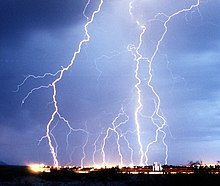Ìtanná: Ìyàtọ̀ láàrin àwọn àtúnyẹ̀wò
No edit summary |
No edit summary |
||
| Ìlà 1: | Ìlà 1: | ||
{{ìṣegbéringbérinoníná}} |
{{ìṣegbéringbérinoníná}} |
||
[[File:Lightning3.jpg|thumb|alt=Multiple lightning strikes on a city at night|[[Lightning]] is one of the most dramatic effects of electricity.]] |
[[File:Lightning3.jpg|thumb|alt=Multiple lightning strikes on a city at night|[[Lightning]] is one of the most dramatic effects of electricity.]] |
||
'''Ìtanná''' (''Electricity'') |
'''Ìtanná''' (''Electricity'') ni [[science|sayensi]], [[engineering|iseero]], [[technology|oroiseona]] ati àwon isele eleda to je mo bi awon [[electric charge|adajo ina]] se wa ati bi won se un sanlo. Itanna unfa orisirisi isele ''onitanna'', bi [[lightning|monamona]], [[static electricity|ina ojukan]], [[electromagnetic induction|ifasara onigberingberin onina]] ati isanlo [[electrical current|iwo onitanna]] ninu waya onitanna. Bakanna, itanna gba idasile ati igbasodo [[electromagnetic radiation|iranka onigberingberin onina]] bi awon [[radio waves|iru radio]] laye. |
||
Ninu itanna, awon adijo unse awon [[electromagnetic field|papa onigberingberin onina]] ti won unsise lori awon adijo miran. Itanna unsele nitori orisirisi awon iru isiseeda: |
|||
* '''[[electric charge]]''': |
* '''[[electric charge|adijo ina]]''': ini awon [[subatomic particle|igbonwo abeatomu]] melo kan, to unso bi [[electromagnetic interaction|ibasepo onigberingberin onina]] won yio se ri. Awon elo ti won ti je didijo lonitanna yio je ninipa lori latowo awon papa onigberingberin onina be sini yio tun pese won. |
||
* '''[[electric current]]''': |
* '''[[electric current|iwo ina]]''': isan awon igbonwo ti won ti je didijo lonitanna, won saba je wiwon ni eyo [[ampere]]. |
||
* '''[[electric field]]''' ( |
* '''[[electric field|papa ina]]''' (e wo [[electrostatics|isiseojukan onina]]): an especially simple type of electromagnetic field produced by an electric charge even when it is not moving (i.e., there is no [[electric current]]). The electric field produces a force on other charges in its vicinity. Moving charges additionally produce a [[magnetic field]]. |
||
* '''[[electric potential]]''': the capacity of an electric field to do [[Work (mechanics)|work]] on an [[electric charge]], typically measured in [[volt]]s. |
* '''[[electric potential]]''': the capacity of an electric field to do [[Work (mechanics)|work]] on an [[electric charge]], typically measured in [[volt]]s. |
||
* '''[[electromagnets]]''': electrical currents generate magnetic fields, and changing magnetic fields generate electrical currents |
* '''[[electromagnets]]''': electrical currents generate magnetic fields, and changing magnetic fields generate electrical currents |
||
Àtúnyẹ̀wò ní 02:36, 13 Oṣù Kàrún 2012
| Ìṣegbéringbérin oníná |
|---|
 |

Ìtanná (Electricity) ni sayensi, iseero, oroiseona ati àwon isele eleda to je mo bi awon adajo ina se wa ati bi won se un sanlo. Itanna unfa orisirisi isele onitanna, bi monamona, ina ojukan, ifasara onigberingberin onina ati isanlo iwo onitanna ninu waya onitanna. Bakanna, itanna gba idasile ati igbasodo iranka onigberingberin onina bi awon iru radio laye.
Ninu itanna, awon adijo unse awon papa onigberingberin onina ti won unsise lori awon adijo miran. Itanna unsele nitori orisirisi awon iru isiseeda:
- adijo ina: ini awon igbonwo abeatomu melo kan, to unso bi ibasepo onigberingberin onina won yio se ri. Awon elo ti won ti je didijo lonitanna yio je ninipa lori latowo awon papa onigberingberin onina be sini yio tun pese won.
- iwo ina: isan awon igbonwo ti won ti je didijo lonitanna, won saba je wiwon ni eyo ampere.
- papa ina (e wo isiseojukan onina): an especially simple type of electromagnetic field produced by an electric charge even when it is not moving (i.e., there is no electric current). The electric field produces a force on other charges in its vicinity. Moving charges additionally produce a magnetic field.
- electric potential: the capacity of an electric field to do work on an electric charge, typically measured in volts.
- electromagnets: electrical currents generate magnetic fields, and changing magnetic fields generate electrical currents
In electrical engineering, electricity is used for:
- electric power (which can refer imprecisely to a quantity of electrical potential energy or else more correctly to electrical energy per time) that is provided commercially, by the electrical power industry. In a loose but common use of the term, "electricity" may be used to mean "wired for electricity" which means a working connection to an electric power station. Such a connection grants the user of "electricity" access to the electric field present in electrical wiring, and thus to electric power.
- electronics which deals with electrical circuits that involve active electrical components such as vacuum tubes, transistors, diodes and integrated circuits, and associated passive interconnection technologies.
Electrical phenomena have been studied since antiquity, though advances in the science were not made until the seventeenth and eighteenth centuries. Practical applications for electricity however remained few, and it would not be until the late nineteenth century that engineers were able to put it to industrial and residential use. The rapid expansion in electrical technology at this time transformed industry and society. Electricity's extraordinary versatility as a means of providing energy means it can be put to an almost limitless set of applications which include transport, heating, lighting, communications, and computation. Electrical power is the backbone of modern industrial society, and is expected to remain so for the foreseeable future.[1]
The word electricity is from the New Latin ēlectricus, "amber-like"[a], coined in the year 1600 from the Greek ήλεκτρον (electron) meaning amber, because electrical effects were produced classically by rubbing amber.

|
Àyọkà yìí tàbí apá rẹ̀ únfẹ́ àtúnṣe sí. Ẹ le fẹ̀ jù báyìí lọ tàbí kí ẹ ṣàtúnṣe rẹ̀ lọ́nà tí yíò mu kúnrẹ́rẹ́. Ẹ ran Wikipedia lọ́wọ́ láti fẹ̀ẹ́ jù báyìí lọ. |
Itokasi
- ↑ Jones, D.A. (1991), "Electrical engineering: the backbone of society", Proceedings of the IEE: Science, Measurement and Technology, 138 (1): 1–10, doi:10.1049/ip-a-3.1991.0001
